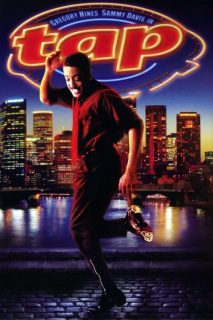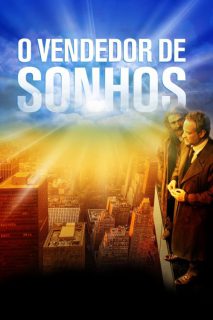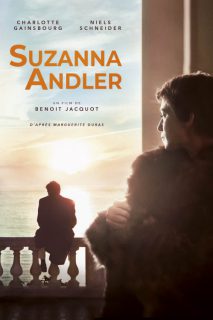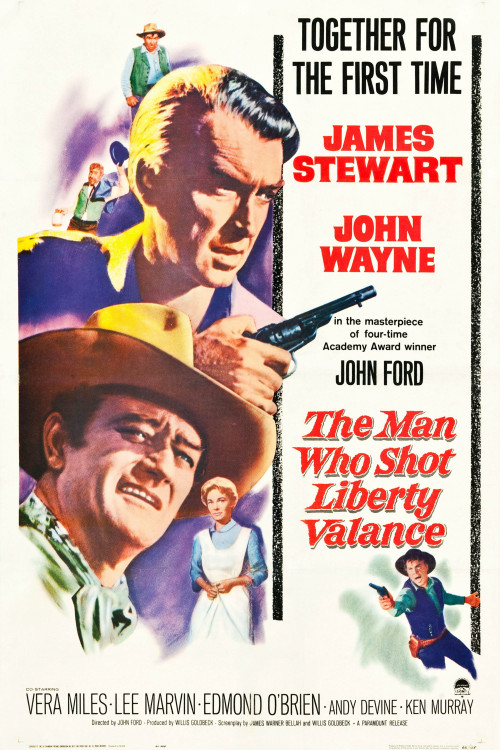
- Year: 1962
- Released: 22 Apr 1962
- Country: United States
- Adwords: Nominated for 1 Oscar. 4 wins & 4 nominations total
- IMDb: https://www.imdb.com/title/tt0056217/
- Rotten Tomatoes: https://www.rottentomatoes.com/m/the_man_who_shot_liberty_valance
- Metacritics: https://www.metacritic.com/movie/the-man-who-shot-liberty-valance
- Available in: 720p, 1080p,
- Language: English
- MPA Rating: Approved
- Genre: Drama, Western
- Runtime: 123 min
- Writer: James Warner Bellah, Willis Goldbeck, Dorothy M. Johnson
- Director: John Ford
- Cast: James Stewart, John Wayne, Vera Miles
- Keywords: lawyer, funeral, showdown, cowboy, outlaw,
 | 8.1/10 |
 | 94/100 |
The Man Who Shot Liberty Valance Storyline
Senator Ranse Stoddard returns to the city of Shinbone in the Wild West, to go to the funeral of his friend, Tom Doniphon. To a journalist, who’s wondering what the senator is doing in Shinbone, he tells how his career started as “the man who shot Liberty Valance”. As a lawyer he came to Shinbone to bring law and order to the west by means of law books. When the stagecoach is held up by outlaws, he is savagely beaten by Liberty Valance. He survives the attack and is nursed by his future wife, Hallie. Hallie is being wooed by a local rancher, Tom Doniphon. Ranse teaches the people of Shinbone to read and write, all the while trying to find a way of bringing Valance to justice. He finally takes up a gun and faces Valance in a menacing shootout…
The Man Who Shot Liberty Valance Play trailer
The Man Who Shot Liberty Valance Photos


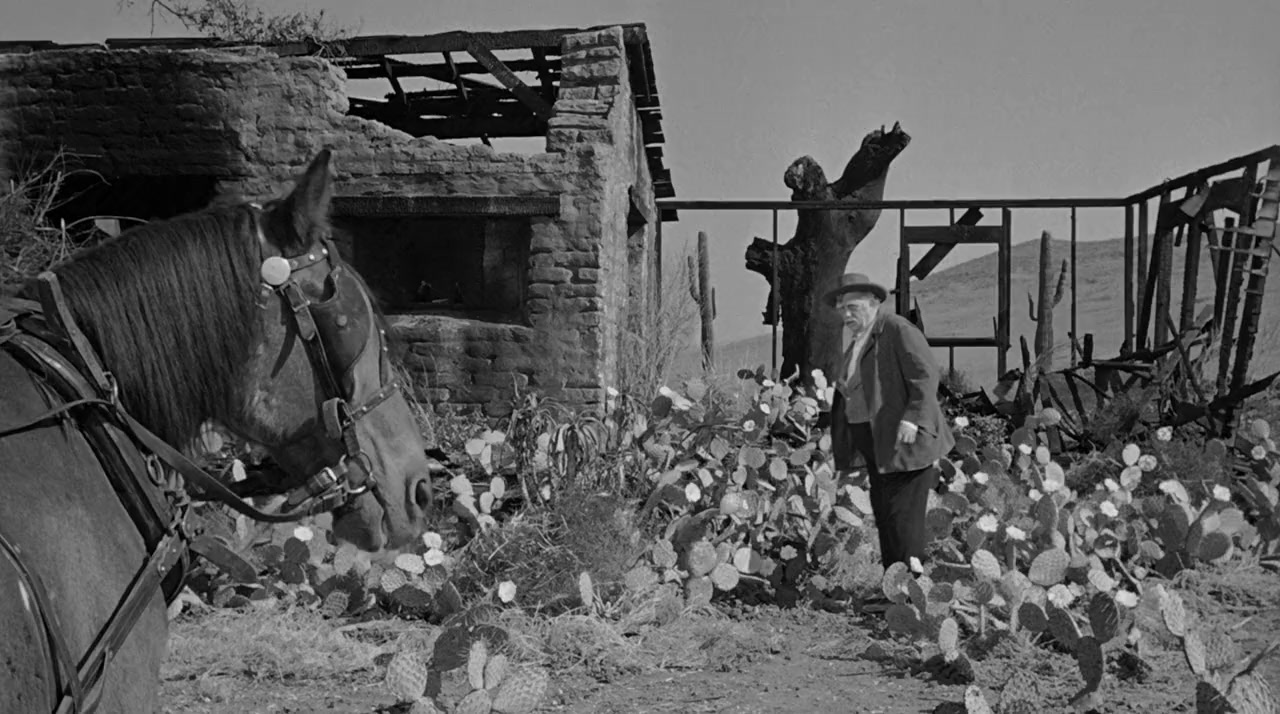
The Man Who Shot Liberty Valance Torrents Download
| 720p | bluray | 1 GB | magnet:?xt=urn:btih:3440AD0B2FF1E3542896DF9196F469E99092234D | |
| 1080p | bluray | 1.95 GB | magnet:?xt=urn:btih:340A32A17CED65E99FAE697B16ADB9405D0A1603 |
The Man Who Shot Liberty Valance Subtitles Download
| Danish | subtitle The.Man.Who.Shot.Liberty.Valance.1962.720p.BluRay.x264. | |
| English | subtitle The.Man.Who.Shot.Liberty.Valance.1962.720p.BluRay.x264. | |
| English | subtitle The.Man.Who.Shot.Liberty.Valance.1962.720p.BluRay.x264. | |
| Greek | subtitle The.Man.Who.Shot.Liberty.Valance.1962.720p.BluRay.x264. | |
| Spanish | subtitle The.Man.Who.Shot.Liberty.Valance.1962.720p.BluRay.x264. | |
| Swedish | subtitle The.Man.Who.Shot.Liberty.Valance.1962.720p.BluRay.x264. |
The Man Who Shot Liberty Valance Movie Reviews
Ford’s Last Big One
It’s a sad movie in many ways. Ford is closing the book on his meditations on progress here. The black and white photography itself is rather depressing — most of the scenes, including all the important ones, seem to take place at night, in the dark. And what do they show us? As Edmund O’Brien puts it, the West began with Indians and buffalo and the only law was survival. Then the cattlemen moved in and took the land over and the law was that of the hired gun. Now the West has been settled by hard-working farmers and turns into a garden, once the power brokers are out of the way. But it’s a wistful garden. The cactus roses have disappeared and been replaced by turnips. And the rowdy, raucous, plain-speaking heroes and villains have been replaced by pretentious blowhard politicians of the sort that Ransom Stoddard (James Stewart) has become.
The framing story begins with Senator Stewart and his wife, Vera Miles, coming back to Shinbone for the funeral of the uknown Tom Doniphon (John Wayne). “Where are his boots?,” Stewart asks upon seeing Wayne’s body laid out, “Put his boots on.” (Ford claimed this incident was borrowed from Tom Mix’s funeral.) A few of the old crowd are still around but the streets of Shinbone are empty and are a tired gray. Everyone is now old. Stewart patronizes Wayne’s old retainer, Pompey (Woody Strode), giving him a handful of bills and saying, “Pork chop money.” Some “garden”!
Well, if the present is filled with nostalgia, the past is lively enough, and the flashback, which is to say most of the film, is full of action and gusto. People just don’t eat in John Qualen’s restaurant. They eat huge platters of steaks, beans, potatoes, and deep dish apple pie. The steaks come sizzling from the vast greasy grill and are large enough to hang over the edges of the over-sized platters. Lee Marvin and his henchmen (Lee Van Cleef and Strother Martin) enact their villainy with relish. John Wayne is, of course, the hero of the tale. You can tell because, in addition to his John Wayneness, he wears the only black and white outfit in the cast, which draws attention to his figure whenever it is on screen.
In fact, though, Wayne does a reasonably decent job of playing Doniphon after his fall. When he enters the political meeting toward the end, banging open the swinging doors, staggering slightly, bearded, shabby, his magnificent white hat replaced by a battered gray one, slightly bleary, he looks and acts like a man who has been defeated but has not yet died, putting up a brave front with nothing left behind to prop it up. He’s not bad in this scene. For the most part, though, he plays John Wayne, the resolute, proud man of principle. Edmund O’Brien is the comic town drunk and editor, the Thomas Mitchell part, and is given some amusing lines, including quotes from Henry V. (Actually O’Brien was pretty good in MGM’s “Julius Caesar,” as Casca, making Shakepeare’s lines believable enough.)
The principle Doniphon represents, however, is O’Brien’s second stage of the West’s development. He’s not only a rancher but a gunman, soon to be replaced by farmers and lawyers, but it’s only at the final shootout that he realizes it. He saves Stewart’s life the old-fashioned way, then gives up any plans of marriage to Vera Miles, gets drunk, and drives himself and Pompey back to the ranch he’d planned as a home. He burns the ranch down. He and Strode had a problem shooting the arrival at the ranch. Wayne lost control of the horses and Strode reached over to help. Wayne pushed him brusquely out of the way and Strode fell from the wagon. Angry, he threatened Wayne, and Wayne responded the way Wayne would respond. Strode, a former fullback, was several years younger than Wayne and in good shape. Ford stopped the altercation by shouting that the movie needed Wayne’s face in one piece.
For all its darkness, however, the movie reflects some of Ford’s prejudices in his comic way. A pompous orator at the political meeting (John Carradine) announces in his stentorian public voice that he came here with “a carefully prepared speech” but is going to disregard it and speak the truth. Here he crinkles up the speech and throws it contemptuously to the floor. Someone picks the page up and uncrumples it to find it blank on both sides. The rhetoric is extremely funny — “The bullet-riddled body of an honest citizen?” — recalling Donald Meek in “Young Mister Lincoln.” During a carefully choreographed spontaneous demonstration after the cattlemen’s candidate has been nominated, a band plays, a cowboy rides up onto the speaker’s platform and twirls a lasso, and there is a brief shot of the Chairman staring appalled at the cowboy’s horse lapping water out of the chairman’s pitcher.
But it’s still a sad comment from Ford. His earlier work brimmed with hope for the future. Here, the future has arrived and it makes one long for the past. The principled lawyer is now a windbag politician. It’s the way an old man might feel about life in general.
It’s the way anyone of maturity might feel about reviewing his past when faced with an almost unrecognizable younger person who happens to bear his name.
exceptional Western
This Western stands out from the crowded pack for two reasons. First, it stars BOTH Jimmy Stewart and John Wayne–that’s a lot of star power in these leads and both had done quite a few Westerns. While Wayne had done quite a few more Westerns, Stewart’s all had the distinction of being exceptional films–that’s quite a track record. Second, the story is unusual–and that just doesn’t happy often enough in this genre. The idea of a bully intimidating the towns people ISN’T unique, but the way it was told in flashbacks and the resolution of the problem is quite creative.
Because this is a John Ford directed film, it is naturally of superb quality–with excellent pacing and supporting characters (a Ford trademark of sorts). While I don’t think this film is necessarily his best film with John Wayne (THE QUIET MAN and FORT APACHE, I think, are slightly better), it is still a great film.
The only negative portion of the movie is when John Wayne goes on a bender and burns down his own home. While I understood WHY he was so upset, his reaction just seemed like a big temper tantrum and was pretty unrealistic. A minor quibble, but a quibble nonetheless.
“When the legend becomes the fact, print the legend!”
The Man Who Shot Liberty Valance has often been dismissed for being shot in black-and-white in a colour era. This dismissal I feel is very unfair, as the film is very, very good. Yes there could well be one or two stereotyped supporting characters, but I cannot deny how intelligent and thought-provoking this film is.
The themes in The Man Who Shot Liberty Valance are very complex, but guess what, the writing here is written with such skill it all appears so simple. The cinematography is equally as skillful, with grand scenery and a more primitive even innocent west is painted here. The story is often told in flashback, but with a twist that is very unpredictable, and John Ford’s direction is solid as rocks.
The acting is very fine, John Wayne gives a superb performance portraying a western icon, and James Stewart gives memorable support. Lee Marvin is also brilliant as the Liberty Valance of the title. Overall, if you like westerns, James Stewart or John Wayne then by all means see The Man Who Shot Liberty Valance. 9.5/10 Bethany Cox

